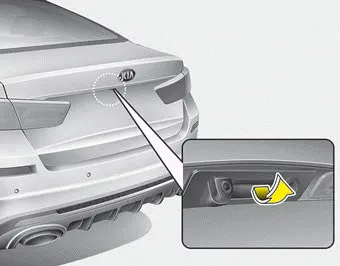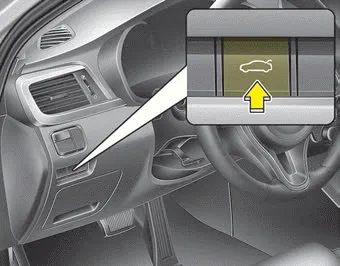Kia Optima DL3: Features of your vehicle / Trunk
Opening the trunk

1.Make sure the shift lever is in P (Park, for automatic transmission) and set the parking brake.
2.Then do one of the following :
- Press the Remote key or Smart Key Trunk Unlock button for more than one second.
- Press the button on the trunk itself with the Smart Key in your possession.

- To open the trunk from inside the vehicle, push the trunk lid release button.
✽ NOTICE
In cold and wet climates, trunk lock and trunk mechanisms may not work properly due to freezing conditions.
WARNING
The trunk swings upward. Make sure no objects or people are near the rear of the vehicle when opening the trunk.
CAUTION
Make certain that you close the trunk before driving your vehicle. Possible damage may occur to the trunk torsion bars and attached hardware if the trunk is not closed prior to driving.
Closing the trunk
To close, lower the trunk lid, then press down on it until it locks. To be sure the trunk lid is securely fastened, always check by trying to pull it up again.
WARNING - Exhaust Fumes
The trunk lid should always be kept completely closed while the vehicle is in motion. If it is left open or ajar, poisonous exhaust gases may enter the car and serious illness or death may result.
WARNING
Make sure your hands, feet and other parts of your body are safely out of the way before closing the trunk.
The child safety lock is provided to help prevent children from accidentally opening the rear doors from inside the vehicle. The rear door safety locks should be used whenever children are in the vehicle.
Your vehicle is equipped with an emergency trunk release lever located inside the trunk. If someone is inadvertently locked in the trunk, moving the handle in the direction of the arrow will release the trunk latch mechanism and open the trunk.
Other information:
Kia Optima DL3 2019-2025 Service and Repair Manual: Power Door Lock Module
Repair procedures Inspection When prying with a flat-tip screwdriver or use a prying trim tool, wrap it with protective tape, and apply protective tape around the related parts, to prevent damage.
Kia Optima DL3 2019-2025 Service and Repair Manual: Compressor
Description and operation Description The compressor is the power unit of the A/C system. It is located on the side of engine block and driven by a V-belt of the engine. The compressor changes low pressure and low temperature refrigerant gas into high pressure and high temperature refrigerant gas.
Categories
- Manuals Home
- Kia Optima Owners Manual
- Kia Optima Service Manual
- Cylinder Head
- SRSCM
- Rear Combination Lamp
- New on site
- Most important about car
